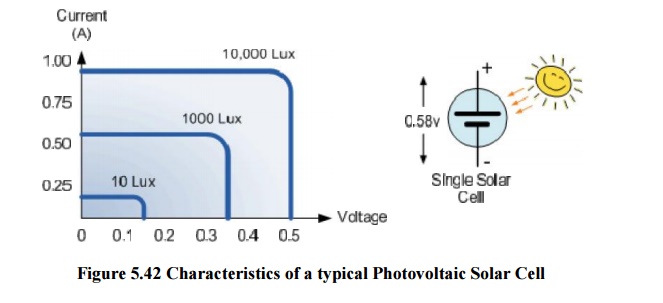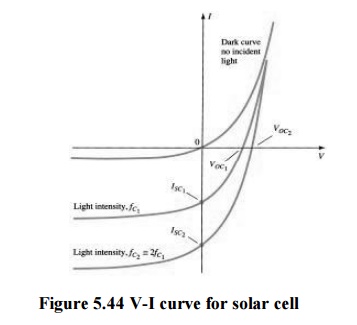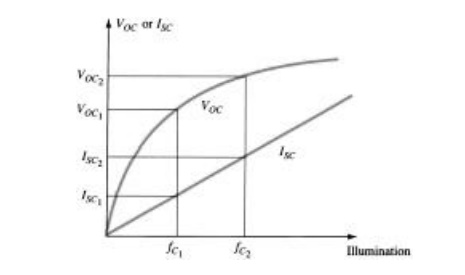Chapter: Electronic Devices : Power Devices and Display Devices
Photovoltaic Cells
PHOTOVOLTAIC CELLS
The most
common type of photovoltaic light sensor is the Solar Cell. Solar cells convert
light energy directly into DC electrical energy in the form of a voltage or
current to a power a resistive load such as a light, battery or motor. Then
photovoltaic cells are similar in many ways to a battery because they supply DC
power.
However,
unlike the other photo devices we have looked at above which use light
intensity even from a torch to operate, photovoltaic solar cells work best
using the suns radiant energy.
Solar
cells are used in many different types of applications to offer an alternative
power source from conventional batteries, such as in calculators, satellites
and now in homes offering a form of renewable power.
Photovoltaic Cell
Photovoltaic
cells are made from single crystal silicon PN junctions, the same as
photodiodes with a very large light sensitive region but are used without the
reverse bias. They have the same characteristics as a very large photodiode
when in the dark.
When
illuminated the light energy causes electrons to flow through the PN junction
and an individual solar cell can generate an open circuit voltage of about
0.58v (580mV). Solar cells have a “Positive” and a “Negative” side just like a
battery.
Individual
solar cells can be connected together in series to form solar panels which
increases the output voltage or connected together in parallel to increase the
available current. Commercially available solar panels are rated in Watts,
which is the product of the output voltage and current (Volts times Amps) when
fully lit.
Characteristics of a typical Photovoltaic Solar
Cell

Figure 5.42 Characteristics of a typical
Photovoltaic Solar Cell
The
amount of available current from a solar cell depends upon the light intensity,
the size of the cell and its efficiency which is generally very low at around
15 to 20%. To increase the overall efficiency of the celll commercially
available solar cells use polycrystalline silicon or amorphous silicon, which
have no crystalline structure, and can generate currents of between 20 to 40mA
per cm2.
Other
materials used in the construction of photovoltaic cells includ e Gallium
Arsenide,
Copper
Indium Diselenide and Cadmium Telluride. These different materials each have a
different spectrum band response, and so can be “tuned” to produce an output
voltage at different wavelengths of light.
In this
tutorial about Light Sensors, we have looked at several exammples of devices
that are classed as Light Sensors. T his includes those with and those without
PN-junctions that can be used to measure the intensity of light.
In the
next tutorial we will look at output devices called Actuators. Actuators
convert an electrical signal into a correspo nding physical quantity such as
movement, force, or sound. One such commonly used output de vice is the
Electromagnetic Relay.
SOLAR CELLS
In recent
years, there has been increasing interest in the solar cell as an alternative
source of energy. When we consider that the power density received from the sun
at sea level is about 100 mW/cm2 (1 kW/m2), it is certainly an energy source
that requires further research and development to maximize the conversion
efficiency from solar to electrical energy.

Figure 5.43 (a) cross section;
(b) top view
The basic construction of a silicon p-n junction
solar cell appears in Figurre 5.43. As shown in the top view, every effort is
made to ensure that the surface area perpendicular to the sun is a maximum. Als
o, note that the metallic conductor connected to the p-type material and the
thickness of the p-type material are such that they ensure that a maximum
number of photons of light energy will reach the junction
A photon of light energy in this region may collide
with a va lence electron and impart to it sufficient energy to leave the parent
atom. The result is a generation of free electrons and holes. This phenomenon
will occur on each side of the junction.
In the
p-type material, the newly generated electrons are minority carriers and will
move rather freely across the junction as explained for the basic p-n junction
with no applied bias. A similar discussion is true for the holes generated in
the n-type material.
The result is an increase in the minority-carrier
flow, which is opposite in direction to the conventional forward current of a
p-n junction. This increase in reverse current is shown in Figure 5.44. Since
V= 0 anywhere on the vertical axis and represents a short-circuit condition,
the current at this intersection is called the short-circuit current and is
represented by the notation ISC.

Figure 5.44 V-I curve for solar
cell
Under open-circuit co nditions (id = 0), the
photovoltaic voltage V OC will result. This is a logarithmic function of t he
illumination, as shown in Figure 5.45. V OC is the terminal voltage of a
battery under n o-load (open-circuit) conditions. Note, however, in the same
figure that the short- circuit current is a linear function of the
illumination.
That is,
it will double for the same increase in illumination ( fC1 and 2fC1 in Figure
5.45) while the change in VOC is less for this region. The major increase in
VOC occurs for lower-level increases in illumination. Eventually, a further
increase in illumination will have very little effect on VOC, a lthough ISC
will increase, causing the power capabilities to increase.

Figure 5.45 Voc and Isc versus
illumination for solar c ell
Selenium
and silicon are the most widely used materials for solar cells, although
gallium arsenide, indium arsenide, and cadmium sulfide, among others, are also
used.
Related Topics